Subtotal: £26.13
6 X Ember Tetras – Hyphessobrycon Amandae – South American Tetras (6), Stunning Freshwater Fish that Thrives in Planted Aquariums, Ideal Companions for Peaceful Community Setups
£14.99 Original price was: £14.99.£12.58Current price is: £12.58.
Welcome these beautiful creatures into your aquarium! This listing includes 6 individual Ember Tetras (Hyphessobrycon Amandae), stunning freshwater fish known for their vibrant colors. Perfect for planted tanks, they thrive as peaceful companions in community setups. Enhance your aquatic environment today.
1985 in stock
Species Introduction
The Ember Tetra, scientifically known as Hyphessobrycon amandae, is a captivating species of freshwater fish native to the warm, slow-moving streams and rivers of South America. These small, vibrant fish are part of the Characidae family and are renowned for their stunning coloration, particularly the bright orange-red hue that adorns their bodies. Typically reaching a maximum length of about 4 cm (1.6 inches), Ember Tetras are ideal for smaller aquariums and are often favored by aquarists for their peaceful nature and compatibility with a variety of tank mates. Their natural habitat consists of densely planted areas where they can find shelter and forage for food, making them a perfect addition to planted aquariums. These beautiful creatures thrive in well-maintained environments that mimic their natural surroundings, which is essential for their health and well-being.
Care Requirements Dashboard
| Optimal Living Conditions | |
|---|---|
| Water Temperature | 24-27°C (75-81°F) |
| pH Level | 6.5-7.5 |
| Water Hardness | 4-12 dKH |
| Minimum Tank Size | 80L (20 gal) |
| Salinity | Freshwater |
| Care Level | Beginner Friendly |
Tank Mate Compatibility Guide
Great Tank Mates
- Other peaceful community fish
- Corydoras catfish
- Small tetras
- Peaceful dwarf shrimp
Avoid These Tank Mates
- Aggressive cichlids
- Large predatory fish
- Fin nippers
Compatibility Note: Always research specific species requirements and observe fish behavior when introducing new tank mates. Individual fish personalities can vary!
Natural Behavior & Temperament
Ember Tetras are known for their peaceful demeanor and social behavior, making them ideal candidates for community aquariums. In their natural habitat, they are often found swimming in schools, which provides them with a sense of security and reduces stress. These small fish exhibit a lively swimming pattern, darting through the water and exploring their surroundings. Their social nature means they thrive in groups of at least six individuals, as this mimics their natural schooling behavior. When kept in appropriate numbers, Ember Tetras display vibrant colors and engage in playful interactions with one another. They are generally non-aggressive and can coexist harmoniously with other peaceful species, making them excellent companions in a community aquarium setting.
Tank Setup Guide
Creating an ideal environment for Ember Tetras involves replicating their natural habitat as closely as possible. A well-planted aquarium is essential, as these fish thrive in environments that provide ample hiding spots and swimming space. Use a substrate that is soft and dark in color, such as fine gravel or sand, to enhance their vibrant colors. Incorporating live plants, driftwood, and rocks can create a visually appealing aquascape while providing shelter for the fish. Plants such as Java Moss, Anubias, and Cryptocoryne are excellent choices for a planted tank, as they can thrive in the water conditions preferred by Ember Tetras. Additionally, maintaining a gentle water flow will help mimic the slow-moving waters of their native streams, ensuring a comfortable environment for these delicate fish.
Water Quality Management
Maintaining optimal water quality is crucial for the health and longevity of Ember Tetras. Regular testing of water parameters is essential to ensure that they remain within the recommended ranges. The pH level should be monitored closely, as fluctuations can stress the fish and lead to health issues. A stable temperature between 22 and 28 degrees Celsius (72 to 82 degrees Fahrenheit) is also vital, as Ember Tetras are sensitive to extreme temperature changes. Water hardness should be kept between 2 and 15 dGH, and regular water changes of 20-30% weekly will help to maintain clean and healthy water conditions. Utilizing a high-quality filtration system can assist in keeping the water clear and free from harmful toxins, ensuring a safe environment for these beautiful fish.
Feeding & Nutrition
Ember Tetras are omnivorous and thrive on a varied diet that includes high-quality flake food, micro-pellets, and live or frozen foods such as brine shrimp, daphnia, and bloodworms. A balanced diet is essential for their health, coloration, and overall well-being. It is recommended to feed them small amounts 2-3 times a day, ensuring that they consume all the food within a few minutes to prevent water quality issues. Providing a mix of high-quality dry food and occasional live or frozen treats will help to enhance their natural colors and promote healthy growth. Additionally, it is important to adjust feeding quantities based on the number of fish in the tank and their activity levels, ensuring that all fish receive adequate nutrition without overfeeding.
Health & Wellness
Like all fish, Ember Tetras can be susceptible to various health issues if not cared for properly. Common problems include ich, fin rot, and various parasitic infections. Regular monitoring of water quality and maintaining a stable environment are essential for preventing these issues. Signs of stress or illness may include changes in behavior, such as lethargy, loss of appetite, or abnormal swimming patterns. If any health concerns arise, it is important to act quickly by isolating affected fish and treating them in a separate quarantine tank. Additionally, ensuring that the tank is adequately cycled and that fish are not overcrowded will help to minimize the risk of disease. Providing a balanced diet and maintaining good water quality will also contribute to the overall health and vitality of your Ember Tetras.
Breeding Information
Breeding Ember Tetras can be a rewarding experience for aquarists, as these fish are relatively easy to breed in a home aquarium. To encourage spawning, it is recommended to set up a separate breeding tank with soft, slightly acidic water and plenty of fine-leaved plants for the female to lay her eggs. The ideal conditions for breeding include a temperature of around 26-28 degrees Celsius (79-82 degrees Fahrenheit) and a pH level of 6.0-6.5. Once the female lays her eggs, which can number in the hundreds, it is advisable to remove the parents from the breeding tank, as they may eat their eggs. The eggs will typically hatch within 24-36 hours, and the fry can be fed infusoria or finely crushed flakes until they are large enough to consume small foods. Proper care of the fry is essential for their growth and development.
Acclimation Process
When introducing Ember Tetras to a new aquarium, it is crucial to acclimate them properly to minimize stress and ensure their health. Begin by floating the sealed bag containing the fish in the aquarium for about 15-20 minutes to equalize the temperature. After this, gradually introduce small amounts of aquarium water into the bag over the course of an hour. This process helps the fish adjust to the new water parameters. Once acclimated, gently release the fish into the aquarium using a net, avoiding adding any of the water from the bag to the tank. This method minimizes the risk of introducing any potential contaminants from the store water. Proper acclimation is essential for the well-being of your Ember Tetras and will help them thrive in their new home.
Long-term Care
Ember Tetras have a lifespan of approximately 3 to 5 years when provided with optimal care. To ensure their longevity, it is important to maintain stable water conditions, provide a balanced diet, and monitor their health regularly. Regular water changes and maintaining a clean environment will help prevent disease and promote a healthy living space for your fish friends. As Ember Tetras grow, they may require adjustments in their diet and care routine, so staying informed about their needs is essential. Observing their behavior and interactions with other tank mates will also provide valuable insights into their overall health and happiness. By committing to their long-term care, you can enjoy the beauty and companionship of these vibrant fish for many years.
Natural Habitat Recreation
Recreating the natural habitat of Ember Tetras in your aquarium can greatly enhance their well-being and overall appearance. In the wild, these fish inhabit densely vegetated areas of slow-moving rivers and streams. To mimic this environment, consider incorporating a variety of live plants, such as floating plants and dense foliage, which provide hiding spots and foraging opportunities. Additionally, using driftwood and rocks can create natural barriers and territories, allowing the fish to feel secure. A soft substrate will also help replicate their natural surroundings, as they often forage along the riverbed. By creating a biotope that reflects their native habitat, you not only improve their quality of life but also create a stunning visual display in your aquarium.
Seasonal Care Adjustments
As seasons change, so too can the care requirements for your Ember Tetras. During warmer months, it is important to monitor the water temperature closely, as higher temperatures can lead to stress and health issues. Ensure that the aquarium is not exposed to direct sunlight, which can cause overheating. Conversely, during colder months, consider using a heater to maintain a stable temperature within the ideal range. Additionally, lighting schedules may need to be adjusted to accommodate seasonal changes, ensuring that your fish receive adequate light while still allowing for periods of darkness. By being attentive to seasonal variations, you can provide the best care for your Ember Tetras and promote their health and happiness throughout the year.
Expert Tips
For those looking to enhance their experience with Ember Tetras, consider the following expert tips. First, always introduce new fish slowly to prevent stress and aggression among established tank mates. Quarantine new arrivals for at least two weeks before adding them to the main tank. Second, maintain a consistent feeding schedule to help your fish develop healthy eating habits. Third, consider using a high-quality water conditioner to remove harmful chemicals and toxins from tap water before adding it to the aquarium. Lastly, engage in regular maintenance, including cleaning the substrate and performing water changes, to keep the environment clean and healthy. By following these tips, you can create a thriving community for your Ember Tetras and ensure they flourish in your care.
Troubleshooting
Despite best efforts, aquarists may encounter challenges when caring for Ember Tetras. Common issues include stress from aggressive tank mates, poor water quality, and dietary deficiencies. If you notice signs of stress, such as hiding or erratic swimming, assess the tank environment and consider rearranging decorations to create more hiding spots. Regularly testing water parameters can help identify any imbalances that need to be addressed. If dietary deficiencies are suspected, ensure a varied diet that includes high-quality foods. In cases of illness, isolating affected fish and seeking appropriate treatment is essential. By being proactive and attentive, you can effectively troubleshoot and resolve any issues that arise in your aquarium.
Scientific Background
The Ember Tetra belongs to the family Characidae, which includes many popular aquarium species. Their scientific classification places them within the order Characiformes, known for their diverse range of freshwater fish. Research into the Ember Tetra has revealed insights into their natural behaviors, breeding habits, and dietary needs. Conservation efforts are also underway to protect their habitats in South America, as deforestation and pollution pose significant threats to their populations. Understanding the scientific background of Ember Tetras not only enhances our appreciation for these fish but also emphasizes the importance of responsible aquarium practices and conservation efforts.
Advanced Care Techniques
For experienced aquarists looking to take their care of Ember Tetras to the next level, consider implementing advanced techniques such as breeding programs or specialized feeding regimens. Breeding Ember Tetras can be a rewarding challenge, requiring specific water parameters and environmental conditions to encourage spawning. Additionally, experimenting with different food types, including homemade blends or high-quality frozen foods, can enhance their coloration and overall health. Engaging in regular observation and documentation of their behaviors can also provide valuable insights into their needs and preferences. By adopting advanced care techniques, you can deepen your connection with these beautiful fish and contribute to their well-being.
Frequently Asked Questions
Q: What tank size is required for Ember Tetras?
Ember Tetras thrive in a minimum tank size of 60 litres, which provides ample swimming space and allows for a small school of at least six fish. This species enjoys swimming in groups, and a larger tank helps maintain stable water parameters, reducing stress. A well-planted aquarium will not only mimic their natural habitat but also enhance their vibrant colours. When establishing your tank, ensure there are hiding spots created by plants or decorations, as this can help your tetras feel secure and promote natural behaviour.
✓ Expert Tip
Consider a tank with a horizontal layout, as Ember Tetras prefer to swim at various levels, which a larger footprint can facilitate.
Q: What water parameters do Ember Tetras require?
Ember Tetras prefer soft, slightly acidic to neutral water conditions, ideally between 6.0 to 7.5 pH. The water hardness should be around 2-10 dGH. Maintaining a stable temperature between 24-28°C is also crucial for their health. Regular water changes of 20-30% weekly will help keep nitrates low and promote a healthy environment. Investing in a reliable water testing kit will assist in monitoring these parameters, ensuring your fish friends thrive in their aquatic home.
✓ Expert Tip
Use a sponge filter to maintain gentle water flow and avoid disturbing your tetras, as they prefer calmer waters.
Q: How often should I feed Ember Tetras?
Feeding Ember Tetras should occur two to three times a day with a diet consisting of high-quality flake food, micro-pellets, and occasional frozen or live foods such as brine shrimp or daphnia. It is important to provide only what they can consume within 2-3 minutes to prevent overfeeding, which can lead to water quality issues. Observing their feeding behaviour can help you adjust portions accordingly. During breeding, a higher protein diet can support reproductive health.
✓ Expert Tip
Incorporating a variety of food types can enhance their colouration and overall health.
Q: What are the best tank mates for Ember Tetras?
Ember Tetras are peaceful fish that thrive in community tanks. Suitable tank mates include other small, non-aggressive species like Corydoras catfish, Guppies, and other small tetras such as Neon or Rummy Nose Tetras. Avoid larger or aggressive fish that may view them as prey. It is best to house them in groups of six or more, as this will encourage natural schooling behaviour and reduce stress. Observing interactions in your tank can help ensure that all fish coexist harmoniously.
✓ Expert Tip
Introduce new fish gradually to minimise territorial disputes and stress.
Q: How do I properly acclimatise Ember Tetras to my aquarium?
Acclimatising Ember Tetras is crucial to their health. Begin by floating the sealed bag in your aquarium for about 15-20 minutes to equalise the temperature. After this, gradually mix small amounts of aquarium water into the bag every 5-10 minutes for an additional 30-60 minutes. This process helps them adjust to differences in water chemistry. Finally, gently release the fish into the aquarium using a net, discarding the water from the bag to prevent introducing any potential contaminants.
✓ Expert Tip
Avoid adding the fish to the tank immediately after purchase; allow them time to acclimatise properly.
Q: What are the signs of healthy Ember Tetras?
Healthy Ember Tetras exhibit bright colours and clear eyes. They should swim actively and engage with their surroundings. Observe their behaviour; if they are schooling, interacting, and exploring, they are likely in good health. Signs of illness may include lethargy, frayed fins, or changes in colour. Regularly monitoring their behaviour and appearance can help catch any potential health issues early, allowing for timely intervention.
✓ Expert Tip
Maintain a stable environment to minimise stress and promote overall health.
Q: How do I successfully breed Ember Tetras?
To breed Ember Tetras, provide a separate breeding tank with soft, slightly acidic water and plenty of fine-leaved plants for the eggs to adhere to. Condition the breeding pair with high-quality foods to encourage spawning. Once ready, the female will lay eggs, which should hatch within 24-36 hours. After hatching, remove the parents to prevent them from eating the fry. Feed the fry with infusoria or finely crushed flakes until they are large enough for regular food.
✓ Expert Tip
Ensure the breeding tank has low light levels to mimic their natural spawning conditions.
Q: What temperature should I maintain for Ember Tetras?
Ember Tetras thrive in a temperature range of 24-28°C. It is essential to maintain a stable temperature, as fluctuations can cause stress and lead to health issues. Using a reliable aquarium heater and thermometer will help you monitor and control the temperature effectively. Additionally, ensure that the heater is properly sized for your tank to maintain consistent warmth throughout the water.
✓ Expert Tip
Consider using a heater with adjustable settings to easily manage temperature changes throughout the year.
Q: How long do Ember Tetras typically live in captivity?
With proper care, Ember Tetras can live for around 2 to 4 years in captivity. Factors such as water quality, diet, and tank conditions significantly influence their lifespan. Regular maintenance, including water changes and monitoring for diseases, will help ensure a long and healthy life for your fish friends. Providing a stress-free environment with appropriate tank mates also contributes to their overall well-being.
✓ Expert Tip
Keep records of your water parameters and any changes made to the tank to help identify factors affecting their health.
Q: What type of substrate is most suitable for Ember Tetras?
Ember Tetras prefer a soft substrate such as fine gravel or sand, which mimics their natural habitat and allows them to forage comfortably. Soft substrates prevent injury to their delicate fins and provide a more natural environment. Additionally, incorporating live plants can enhance the aesthetics of the tank while offering hiding spots and food sources for your tetras. Ensure that any decorations are smooth to avoid harming your fish.
✓ Expert Tip
Consider adding leaf litter or natural materials to create a more authentic environment for your tetras.
Q: What behavioural patterns should I expect from Ember Tetras?
Ember Tetras are known for their lively and social behaviour. They enjoy schooling with their own kind, often seen darting around the tank in groups. They exhibit a peaceful disposition, which makes them ideal for community tanks. Occasionally, you may observe them displaying slight territorial behaviour, especially during breeding. Providing ample swimming space and hiding spots will help reduce any potential stress and allow them to express their natural behaviour.
✓ Expert Tip
Observing their behaviour can provide insights into their health and comfort in the tank.
Q: How can I prevent common diseases in Ember Tetras?
Preventing diseases in Ember Tetras primarily revolves around maintaining a clean and stable environment. Regular water changes, proper filtration, and monitoring water parameters are essential. Avoid overfeeding, as this can lead to poor water quality. Quarantining new fish before introducing them to your main tank can help prevent the spread of diseases. Additionally, providing a varied diet rich in nutrients can bolster their immune systems, making them less susceptible to illness.
✓ Expert Tip
Regularly observe your fish for any signs of illness, as early detection is key to successful treatment.
Q: What lighting conditions do Ember Tetras prefer?
Ember Tetras thrive in dim to moderate lighting, which helps them feel secure and encourages natural behaviours. Bright lighting can stress them, leading to hiding and reduced activity. Using a combination of live plants and floating plants can diffuse lighting intensity and create a more comfortable environment. A standard aquarium light with a timer to simulate a natural day/night cycle will support their well-being and maintain the aesthetic appeal of your aquarium.
✓ Expert Tip
Adjust the lighting duration to around 8-10 hours daily to mimic their natural habitat.
Q: How do I recognise stress in Ember Tetras?
Signs of stress in Ember Tetras can include erratic swimming, hiding excessively, or losing colour vibrancy. They may also exhibit clamped fins or reduced appetite. Stress can arise from poor water quality, inappropriate tank mates, or rapid changes in their environment. Regular monitoring of their behaviour and environment can help identify stressors early, allowing you to take corrective action to ensure their comfort and well-being.
✓ Expert Tip
Maintain a calm and stable environment to help minimise stress for your fish friends.
Q: What natural habitat conditions should I replicate for Ember Tetras?
In their natural habitat, Ember Tetras inhabit slow-moving waters in South America, characterised by dense vegetation and submerged leaf litter. To replicate these conditions, create a well-planted aquarium with plenty of hiding spots, using soft, sandy substrates. Incorporating driftwood and leaf litter will add to the natural feel of the environment. Maintaining slightly acidic, soft water will further mimic their habitat, promoting their health and behaviour.
✓ Expert Tip
Consider using natural decorations to enhance the aesthetics and comfort of your aquarium.


 Golden Eyes Vampire Crab - Geosesarma Sp. - Decapod Crustacean
Golden Eyes Vampire Crab - Geosesarma Sp. - Decapod Crustacean 
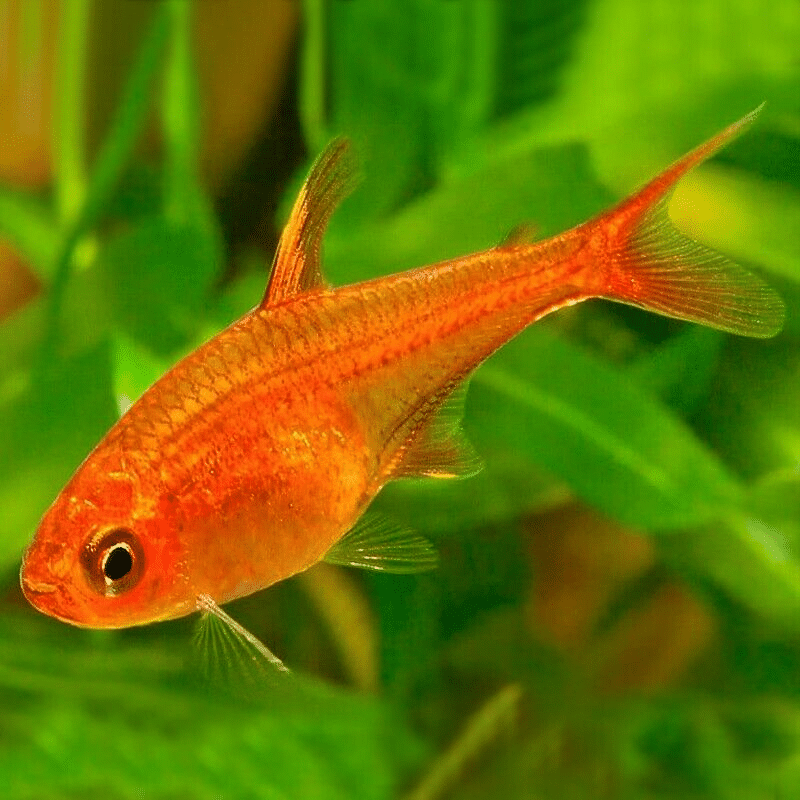
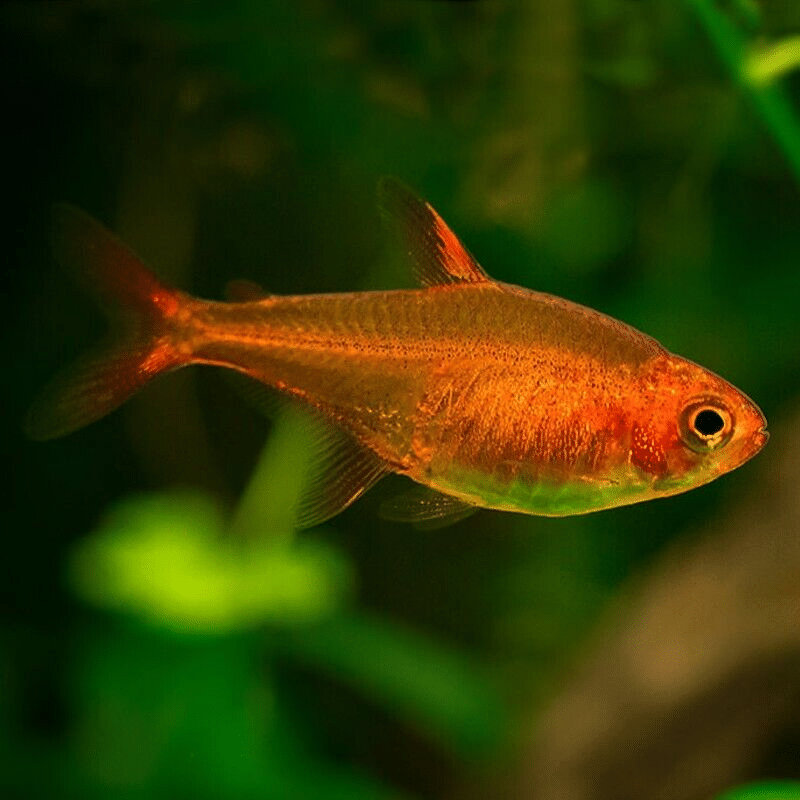


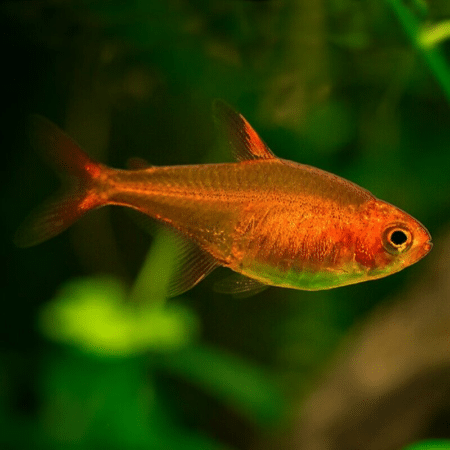
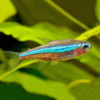
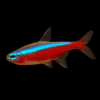








Emily Carter (verified owner) –
I recently added 6 Ember Tetras to my 20-gallon tank, and I couldn’t be happier with my choice! These little guys are not just beautiful, with their vibrant orange-red hues, but they are also incredibly active and social. It’s been a delight to watch them dart around, interacting with each other and exploring their environment.
After just two weeks, I noticed that they had already formed a close-knit school, which has brought so much life to my aquarium. Compared to the neon tetras I had before, I find Ember Tetras to be a bit more peaceful, making them perfect for community tanks. They’re easy to care for, thriving in a well-planted tank with gentle filtration.
One thing to keep in mind: they do prefer slightly warmer water, around 75-82°F, so investing in a reliable heater was necessary for me. Overall, I highly recommend these tropical fish to anyone looking to add a splash of color and charm to their setup. Especially if you’re a caring fish parent like me, these Tetras will surely bring joy to your aquatic family. I’ll definitely be purchasing more in the future!
Emily Carter (verified owner) –
I recently added a school of 6 Ember Tetras to my planted aquarium, and I couldn’t be happier with my decision! After about two weeks, these little gems have become the stars of my tank. Their vibrant orange and red hues create a stunning contrast against the greenery, and they’re so lively and playful. I’ve noticed they thrive in community settings, happily swimming alongside my neon tetras and other peaceful species.
What I love most about these freshwater fish is their gentle nature. They’ve adjusted beautifully to their environment, and it’s heartwarming to see them interact with each other. I had previously kept other small tetras, but the Ember Tetras definitely have a unique charm that makes them stand out.
A helpful tip: ensure your tank has plenty of plants and hiding spots, as they love to explore and feel secure. My only minor concern is that their colors can appear less vibrant in low light, so I recommend good lighting for the best display. Overall, I highly recommend these tropical fish to anyone looking to enhance their aquarium with beautiful, lively companions! You won’t be disappointed.